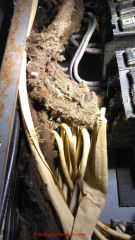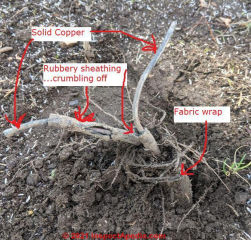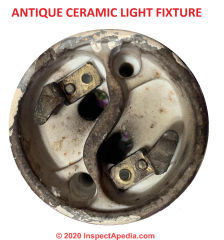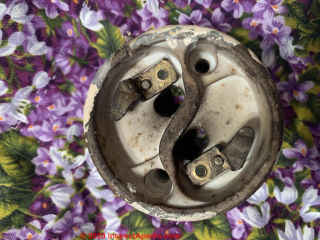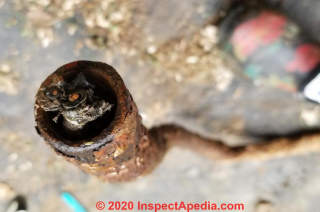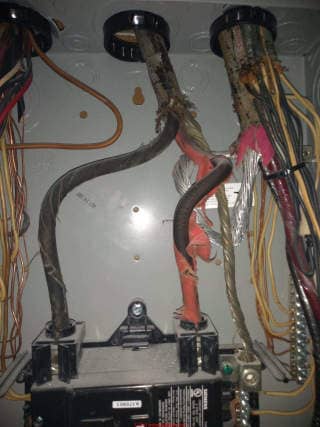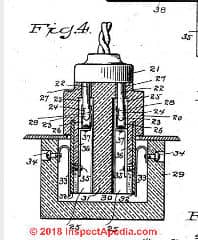 Old Electrical Wiring FAQs
Old Electrical Wiring FAQs
Q&A on types of Electrical Wiring in Older Buildings
- POST a QUESTION or COMMENT about old house wiring, knob & tube, old fuse panels, old house wiring condition & safety
Q&A on the history of electrical wire & electrical wiring & on how to recognize knob and tube electrical wiring and unsafe "extension cord" wiring.
In this article series we list common old building electrical wiring system safety concerns and we illustrate types of old electrical wires and devices.
InspectAPedia tolerates no conflicts of interest. We have no relationship with advertisers, products, or services discussed at this website.
Old Electrical Wire Types, Materials, Methods FAQs
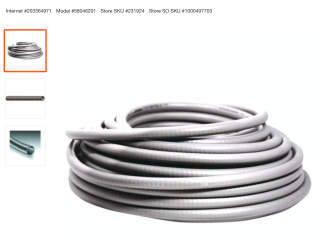 These questions and answers about old electrical wiring or electrical wiring & devices found in old buildings were posted originally at OLD ELECTRICAL WIRING TYPES - be sure to see the photos and descriptions given there.
These questions and answers about old electrical wiring or electrical wiring & devices found in old buildings were posted originally at OLD ELECTRICAL WIRING TYPES - be sure to see the photos and descriptions given there.
On 2021-08-05 by inspectapedia.com.moderator (mod) - ceiling lights and wall receptacles should be on separate circuits
@Saul,
Your gut is on the right digestive tract on this one in that modern practice (more-recent than 1900) for electrical wiring will put ceiling lighting or wall lights on a different circuit than the wall receptacles ("outlets").
That's for two reasons:
1. avoid overloading the circuit
2. increase the chances that the room doesn't remain in darkness if one circuit overloads at night - e.g. if the wall receptacle circuit trips, any lamps plugged to those receptacles will go off but you'll still have ceiling lights.
When you're improving the wiring it's good to separate those and add circuits.
On 2021-08-05 by Saul
Older early 1900s house. Wiring runs along base of walls in rooms with periodic outlets.....then turns verticle to end with bulb socket.....my gut says yikes....comments welcome. Thanks
oh.....the wiring along base of walls is encased in metal housing with periodic outlets built into it....
On 2021-08-07 by inspectapedia.com.moderator (mod)
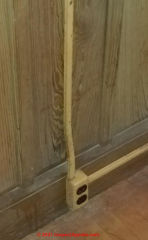 @Anonymous,
@Anonymous,
I am guessing you're asking the age of the wiring in your photo showing surface mount metal conduit and a single surface mount receptacle in a metal box.
It would be a kindness when you post such a question to give us some electrical wiring age guessing Contextual Information such as
The location of the building: country and city
The age of the building
Any notes on history of electrical renovations
That said, if your building is in the U.S. that wiring may well have been installed
before 1971 - the year when the U.S. began using grounded electrical receptacles in new work.
On 2021-08-06 by inspectapedia.com.moderator (mod) - frayed wire loom insulation presents risk
 @Steven,
@Steven,
OK so that's a high-amp circuit, probably originally cloth covered, badly frayed, and perhaps stuffing that area of the panel with electro-kindling.
As I was thinking earlier, this may be frayed wire-loom insulation.
See details
at WIRE LOOM or WIREDUCT WIRE CONDUIT
On investigation you want to watch for a breaker that's not tripping, an overloaded circuit, rats, or mice, or overheating: something to explain why that wire insulation is so frayed. I suspect mice.
Looks as if some inexpert-wiring has been done too - including leaving quite a bit of paper
- more electro-kindling (a fire risk).
On 2021-08-06 by Steven A
The brown furry wire is what I'm curious about. Here are some other photos.
On 2021-08-06 by inspectapedia.com.moderator (mod)
@Steven A,
I see plastic insulated or "NMC" wire and some thick light brown material beneath and to the right of your spider - but I'm not sure just what material you mean.
Looks like an over-crowded electrical panel too.
I also see what looks like a fabric "wire loom" type insulation in your photos - that's quite frayed.
On 2021-08-06 by Steven A
What type of wire is this? The rough looking one?
On 2021-07-27 by inspectapedia.com.moderator (mod) - My dad was on the committee to outlaw aluminum wiring.
@Michael Martin,
While no one is installing solid conductor Branch wire circuits using aluminum it is still permitted and it is common practice to use multi strand aluminum wire for higher amp circuits and for the service entry cable.
I agree with you that it's not what we would prefer.
It's also the case that many electricians install that wire without using the antioxidant paste that they should be using and they certainly don't know about the best practices this method of abrading the wire through the antioxidant as well, as described by Aronstein at this website.
Can you reply us more about your
dad who was on the committee to outlaw aluminum wiring.
What committee, where and when and if you have any details or documentation that would be very useful.
On 2021-07-27 by Michael Martin
My dad was on the committee to outlaw aluminum wiring. I had a trailer home that had it and you could see outlets glowing at night. Our house built around ‘68 had it. We had to pigtail copper with a liquid conductor to correct otherwise no matter how tight or good you made the connection it would not conduct!
So I buy a new townhouse in ‘95 come to find it has aluminum wiring from the meter to my breaker box! I put conductor paste at the terminals to box but don’t know about meter side! But if it’s doing what aluminum wiring normally does wouldn’t that cause resistance and spiking my voltage consumption higher than it really is ??!!
On 2021-05-30 - by (mod) -
@anonymous,Glad to assist, and your questions help me see where we need to add details or to make information more clear.
On 2021-05-30 by anonymous
yes, it does and thank you very much for responding to my question. also thank you for posting a photo with detailed information. and yes of course safety always number one. thank you !
On 2021-05-29 by (mod) - wiring new light to 1920s wiring
@Anonymous,
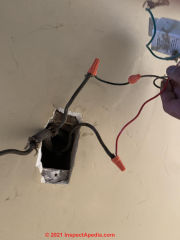 Thank you for a helpful question.
Thank you for a helpful question.
To have space for a detailed reply I repeat your question and answer it at
LIGHT SWITCH WIRING DETAILS
Please take a look and let me know if that helps you sort out your wires -
On 2021-05-29 by Anonymous
i’m removing this motion sensing switch and replacing / connecting it back the regular two way light switch on my old house that was built around the 1920’s.
how do i determine the identification of the (3) wires coming out from the wall as to which is the (hot) (neutral) or (ground) wiring when that are all the same color?
also on the switch i will be replacing it with the switch has more than (3) terminals to connect / replace the wires onto? how do i know which wires go where??
On 2021-05-28 - by (mod) - old amp gauge on Ford tractor
@ron fancher,Sure, that amp meter works by responding to the electrical field of generated by 60 Cycle current running through a wire. You'll see that same method used in clamp-on amp meters they're in the hands of most electricians.
Details are at AMPS MEASUREMENT AUTOMOTIVE DC
where we repeat your question and give a detailed answer;
please take a look and let me know what questions remain.
On 2021-05-28 by ron fancher
I found an old amp gauge on a ford tractor i am restoring, the gauge has no wires attached it just has a loop on the back that the charging wire passes thru, i would like to know more about this design if possible, it works fine and i took it off and put it on another vehicle and it worked fine there too. thanks ron
On 2021-04-24 - by (mod) -
@Drew Phillips,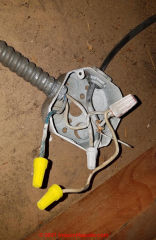 Sorry, but no. No one should pretend they can know which wires are hot, neutral, ground - for sure - from a photo.
Sorry, but no. No one should pretend they can know which wires are hot, neutral, ground - for sure - from a photo. Normally black (or blue, or red) would be hot and white neutral, just as you suggest, and often a pair of wires interrupts the hot to run power through a switch for controlling a light.
But the only safe thing to do is use a DMM or VOM to actually test each wire to be sure it's correctly used.
From the ARTICLE INDEX this may be of use: DMMs VOMs SAFE USE OF
and
DMM DIGITAL MULTIMETER HOW TO USE or you can use a simple neon tester to check for voltage at each wire.
On 2021-04-24 by Drew Phillips
I'm adding lights to a garage ceiling in a 1960-built house. The overhead switched light is fed power by metal conduit with a blue wire and two white wires (light receptacle had blue wire to brass connection, one white wire to silver connection, no ground).
A working electrical outlet taps into this via Romex 12/3 but the ground is left unattached and the black wire is connected to a white wire from the metal conduit source.
I initially though the blue wire would be hot, but perhaps the white wire connected to the Romex black wire is hot, which means the blue wire is neutral.
Given this set-up, can you confirm the hot, neutral and ground of the metal conduit power source? Not sure if this was put in when house was built or later in the 1990's. Many thanks.
On 2021-04-12 - by (mod) - copper coated steel wire or copper clad steel (CCS)
@Ruby, When I find copper wire is "stiffer" it's near its ends where it's been bent-about;
Or what you have could be a hybrid like one of those unusual copper-coated steel products.
For readers who are not familiar with copper coated steel wire, it's still made by various vendors. Here's an example description:
Copper Clad Steel (CCS) is a composite conductor material containing a low carbon steel core surrounded by copper. The copper provides the electrical conductivity and the steel contributes strength to the conductor. The most common grade of CCS used for electrical conductors has a nominal 40% IACS electrical conductivity.
CCS is suitable for applications where high strength and medium conductivity are required. Copper Clad Steel is also suited for high frequency signal applications since high frequency currents travel mainly in the outer skin of a conductor.
CCS is available bare or plated with silver, nickel or tin.
- source: https://fiskalloy.com/
On 2021-04-11 by Ruby
I just replaced outlets and switches in a house built in 1966. The copper wire was so much stiffer than what we use today. Why is that? Both are size 12, copper.
On 2021-04-07 by (mod) - tie together ends of abandoned outdoor electrical circuit ca 1938?
@Tom D,
That could be an old, abandoned electrical service entry, though at #10 that's pretty small (30A).
Yes it's entirely possible that someone would have buried fabric- and rubber- insulated electrical wire;
When I find abandoned wires like that, even after testing to confirm that they are not carrying current, I tie the two ends together with a connector so that should somebody somehow connect the other end to a power source the safety hazard will be immediately apparent (as a fuse will blow).
On 2021-04-07 by Tom D
Had some lawn work done and when I was walking the area, I found this sticking up from the ground. This is about 1 foot from the street and on furthest corner of the property (not near entryway or drive way), so I doubt it was for a resident installed light post or similar.
The wires are solid copper, 2 conductors, very rigid, I measured a piece and it's 10 gauge solid. The house and area was built around 1938. Could this have been old electrical for streetlights based upon proximity to street and the age?
Would they have used fabric wrapped wires underground and such a heavy gauge back in the day? It was clearly disconnected at this end, haven't dug it up to find other end. Have call into town to ask them to come check too. Thanks...Tom D
On 2021-04-04 by (mod) - can I be sure my 1978 doublewide will have copper wiring?
@Judy, it's possible but I certainly wouldn't assume that. Instead I would have the home inspected.
On 2021-04-04 by Judy
I am buying a 1978 double wide will it have copper wiring?
On 2021-03-29 - by (mod) - 2-wire copper with a smooth aluminum sheath
@Eric Lewis,
Thank you very much for that helpful observation. I didn't, from the photograph alone, recognize that we were seeing copper conductors protected by a flexible aluminum sheath or "tubing".
For other readers, this is a very different product from steel metal-conduit used to pull electrical wires.
An example of a modern product that is similar in properties and application is the 1/2 in. x 100 ft. Ultratite Liquidtight Flexible Non-Metallic PVC Conduit
by Southwire that I show below - widely sold at electrical suppliers and building supply stores.
On 2021-03-29 by Eric Lewis
In Sean's photo below there is a 2-wire copper with a smooth aluminum sheath. I installed this in some residences in Wisconsin in the late 1980's. It must have fit the definition of an AC cable as the sheath was the equipment grounding conductor. It seems we used it where exposed to physical damage.
On 2021-02-28 - by (mod) -
Looks like a power distribution cable,
though if found alone (where usually you'd find two hot and one neutral cables) it may not be from an electrical service entry.
...
Is that white covering really concrete?
On 2021-02-28 by Joseph
Any idea what this cable is? It was buried in a public road encased in concrete.
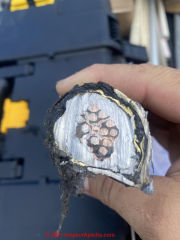
On 2021-01-16 - by (mod) -
Zack
It is never safe to have an open electrical supplies. All electrical splices need to be enclosed in junction boxes. So you'll want to have your electrician survey the home to find out how much of this improper wiring has been done and to correct it.
On 2021-01-16 by Zack
House is pretty old and I feel unsafe having this dangling what kind of box do I need to mount it
On 2020-12-12 - by (mod) -
Bill:
Assuming there is a single 120VAC light fixture you're installing and that you live in a country where 120VAC wire is standard for branch and lighting circuits then the wiring convention would be to connect:
Black (hot) **OR** Red (hot) to the black wire on the new light
White (neutral) to the white wire on the new light
Green on the new light to the metal electrical box AND to the grounding conductor that should be present in your original wiring. However it's possible that your outdoor light circuit does not include a grounding conductor and if so, in my OPINION is unsafe and should be re-wired or at the very least, protected by a GFCI breaker in the electrical panel.
You'd use a VOM or DMM to confirm the actual wiring of each of the wires you find including that both black and red are "hot";
You'd cap off the un-used hot wire using a twist-on connector.
Watch out: if you are not familiar with safe and code compliant electrical wiring you could be shocked or killed.
On 2020-12-12 by Bill
I am replacing a security light on my 1961 built home. The wire's coming out of the cable are white,black,&red. How should I connect the black,white,&green wires on the new light?
On 2020-12-05 - by (mod) -
Dave,
Having had extensive experience with Auction House experts I can tell you that sadly too often they're not expert.
In this case the auction house expert is completely mistaken.
Plastic insulated electrical wire has been in use in the United States since 1926.
That plastic installation may of course be any of several colors including white black green or red. It will be harder than and have a different consistency than rubber insulation.
Rubber wire insulation is usually black or may be black with a white stripe. The main feature is that it's considerably softer on its surface as well as throughout its cross-section then would be plastic. Old rubber insulation will often be crumbly where plastic, if it has not been overheated, will not.
Your friend is welcome to contact us or send photos and we can further discuss the matter if that would be helpful.
On 2020-12-05 by dave obry
I have a friend who is 92 years old, who purchased a guitar from Leo Fender back in 1950. It was Leo's 6th guitar that he made himself in his garage. He is now selling it. A auction house expert. told him that it was not an original because one of the wires in it had plastic conduit on it.
Was plastic conduit available in 1950? How can a person know if its plastic or perhaps rubber? Dave
On 2020-11-22 - by (mod) -
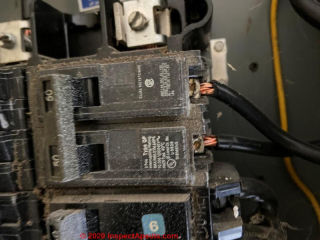 Rick
Rick
That's a common, modern multi-strand copper wire under a 50A breaker;
at 50A it's probably a #8 or #6 multi-stranded copper wire. Use of such wire is perfectly correct and legal provided it's the right size for the amperage it carries.
On 2020-11-18 by Rick Wilson
I have attached a photo -above] of twisted copper wiring used in an apartment building. I have never seen it before. Is it legal? Have there been any problems with it?
I have attached a photo of an electrical panel where I saw it.
On 2020-11-16 by (mod)
Interesting question, Steven.
I haven't seen big red electrical boxes outside buildings - if you can attach a photo of one of these I can better research an answer.
Short of that we've nothing but guessing. Maybe you saw a fire safety system or building electrical shutoff for fire fighters.
On 2020-11-16 by Steven Andrew Hassall
Why did they used to put big red electric boxes on the outside of the buildings in the 60s
Anon:
Please find your photo and our discussion of that ceramic connector, probably for lamps, now at
ANTIQUE LAMPS (BULBS) & CONNECTOR TYPES
On 2020-11-14 by Anonymous
What year were these used as a ceiling box for lights?
On 2020-11-14 - by (mod) - identify this lamp base or "ceiling light box" ?
Anon
Thank you for the question and interesting photo of an apparently antique porcelain electrical fixture connector.
Please find your question and my detailed reply now at the Reader Q&A section near the bottom of the
article ANTIQUE LAMPS (BULBS) & CONNECTOR TYPES.
You may need to clear or refresh your browser cache to see the updated page. We welcome your further photos, comments, questions.
On 2020-11-14 by Anonymous - What year were these used as a ceiling box for lights?
What year were these used as a ceiling box for lights?
On 2020-10-25 by (mod) - install a GFCI receptacle on a 2-wire basement circuit?
Art
Well you can install a GFCI and it'll work - sort-of - but it's also going to have a ground connector opening; and we're now caught between a conflicting requirements:
Basement receptacles need to be GFCI protected;
Un-grounded electrical boxes can only properly support electrical receptacles that do not have a ground opening - though your local inspector might permit instead a stamp or indicator NO GROUND
OR
you might run a grounded wire to that location.
NEVER rely on the metal jacket as the ground path. The ground does not normally carry current but in a failure condition when it does the current should not be flowing in that jacket - someone touching it can be shocked or killed. It's not just theory, I've seen it happen.
On 2020-10-25 by Art
Thanks for your reply...but, hmm, all the older outlets in my house have just 2-wire armored cable supplying them, with the ground provided by a copper wire screwed to the metal duplex box, thus relying upon the metal jacket of the armored cable for the ground.
On 2020-10-25 - by (mod) -
Yes, Art, you can install a 15A Receptacle on the circuit, grounded, GFCI as you suggest; be sure that there's also a ground wire; don't rely on the metal jacket of the armored cable for grounding.
On 2020-10-25 by Art
I have an unused 15A armored cable circuit that at one time powered a now unused well house in basement. There is a single pole switch at the end. Can I repurpose this circuit by replacing the switch with a 15A GFCI outlet? Basement is unfinished, but I would like to add a dedicated outlet here to power a 12A electric fireplace.
On 2020-10-22 by Marc
We bought a house circa 1917 in Whittier, CA with old knob and tube that looks to date to the construction of the house. Porcelain hammered insulators on the studs,, black fabric wrapped cable around a now-brittle black rubber or plastic and a silver wire.
Oily pitch-like covered black sleeves going into switch boxes. I was trying to determine the likelihood of asbestos as some of them need to be moved for modern switches.
On 2020-10-17 - by (mod) -
Steven
Your local electrical inspector is the legal authority on this question; but in general a homeowner isn't required to bring homes up to current code until they are having new work or substantive repair work being done.
Be sure you have a thorough expert home inspection, as the chance that this is the only cost or concern with this home is zero.
Tom N.
Try again to use the add-image button as, sorry, I can't find your image.
On 2020-10-17 by steven R schexnayder
i'm looking to buy a house built in 1930. the electrical outlets are in the base molding approximately 6 inches off the floor. the house is built off the ground about 2 feet. will code in Louisiana make me change the outlets to the 16 inches off the floor?
On 2020-10-11 by Tom N
Hello, can anyone tell me what cable/pipe this is? Thanks!
IMAGE LOST by older version of Clark Van Oyen’s useful Comments code - now fixed. Please re-post the image if you can. Sorry. Mod.
On 2020-10-02 - by (mod) -
Dwight:
you can post a photo using the "add image" button and then perhaps I can give a useful answer.
On 2020-10-01 by Dwight Coder
What us the cylindrical application in the junction box 1930s wiring
On 2020-09-29 - by (mod) -
I'm not sure, Dwight. Please use the "add image" button to post a sharp photo.
On 2020-09-28 by Dwight Coder
there's a small cylinder in the junction box, wht is its purpose? 1930's house wiring
On 2020-09-22 - by (mod) - use of asbestos in mid-century and older electrical wire conduit
 Kim
Kim
You didn't give the country/city of your building and your old electrical conduit, but I would treat the insulation as presumed to contain asbestos.
Here is some pertinent research describing the use of asbestos as insulation in electrical conduit:
- Finkelstein, Murray M. "Mortality among employees of an Ontario factory that manufactured construction materials using chrysotile asbestos and coal tar pitch." American journal of industrial medicine 16, no. 3 (1989): 281-287.
Excerpt:
Ontario for the manufacture of fiber conduit, used for the underground installation of electrical cables … newsprint, bentonite (a hydrated aluminum silicate used as a protective colloid), and chrysotile asbestos to form - Peterson, Roger L., and George M. Joyce. "Fire retardant product for use with electrical cables and the like." U.S. Patent 4,064,359, issued December 20, 1977.
- Stagnitti, Brian M. "Expansion joint for an electrical conduit which is electrically grounded through the expansion joint." U.S. Patent 5,466,890, issued November 14, 1995.
Excerpt:
The packing may comprise an asbestos and copper braid and functions to resist the entry of moisture into the interior of the sleeve
On 2020-09-22 by Kim
no worries, am glad to have found this...it's such a mystery...I haven't found a map w/any buildings on this part of the land in the 1950's..
Here is what I hope is a better pic of the other metal found near the pipe, but not attached...there is a cylindrical edge attached, but I didn't see any other wires in there...it's also metal....Thanks!

On 2020-09-21 - by (mod) -
Yes, Sorry Kim, Clark Van Oyen's Comment Box Code does not permit but one photo per comment. If you find a better web article commenting system or product I'd be glad to consider it.
I can't make out what that surrounding material is; perhaps a type of insulation.
On 2020-09-21 by Anonymous
@Kim,
Thank you! what is all this metal that was surrounding the pipe? I wish I could post more than 1 pic at a time.
On 2020-09-20 - by (mod) -
Kim,
Small (modern) diameter fabric-wrapped copper wire in metal conduit such as in your photos is probably ca 1950.
On 2020-09-20 by Kim
Hi, we found this old electrical conduit in our yard....the land was a farm from ~1900-1985 ish then our subdivision was built.
Can anyone put an age on this? there was also lots of metal around it...it's a solid steel conduit with 3 copper wires wrap in fabric. I have lots of pictures, but I seem to only be able to aedd one. Thanks
On 2020-09-03 - by (mod) -
No, the rating of the wire would not have changed
On 2020-09-03 by Eugene Coffey
I have an older house with an addition estimated to be circa 1970. . During a home inspection prior to sale, it was noted there is a 200 amp breaker panel with a 2/0 aluminum service feed which is currently rated for only 150 amps.
My question is whether 2/0 aluminum was ever approved for 200 amp service and if so when the rating changed. I cannot find any earlier versions of NEC.
On 2020-06-20 - by (mod) -
Thanks for the comment, Ken.
Chuck: just to be clear, the wire size needed on an electrical circuit is not based on how long or how much of the day the circuit is in use.
Rather the wire size is matched to the current ampacity permitted on the circuit. For example a 14AWG copper circuit is rated to carry 15 Amps and would be fused by a 15A fuse or circuit breaker;
See our table of wire sizes and ampacities and typical uses at
SE CABLE & BRANCH CIRCUIT WIRE SIZES vs AMPS
or go right to this
WIRE SIZE TABLE
You'll see that #16 AND #18 copper wire in modern usage would be used for HVAC control circuits and thermostats but not for supplying current to lights or receptacles.
On 2020-06-20 by Chuck
@Ken The Old House Guy, I am a licensed home inspector. I see many NJ homes from that era wired with BX / cloth insulated conductors. Often it is all BX or all knob and tube. I have also seen a mix so anything is posable. It seems that more affluent homes had BX. More modest homes seemed to have Knob and Tube. The Romex was likely a later addition.
I can understand you not finding gas light piping. Depending on the town or location electric was available all day. Earlier times the electric was only on for some hours of the day. I hope this helps.
On 2020-06-19 by Chuck
Have you heard of 16 AWG cloth covered romex in a 1950's home. I found some that at first looks like knob and tube diameter wire. I found two conductors, white and black plastic insulated. The conductor size is notably smaller than 14 AWG. Does not seem to be thermostat wire as it is in a 120 volt J box.
Thank you for your help.
On 2020-05-20 - by (mod) -
Not sure.
Im looking further into the question
On 2020-05-19 by Daniel
Anyone know why this old Gould 120v 60hz 0.4amp motor has a brown red and yellow wires on it and what each one might be?
It goes to a 2 speed switch (I think) and the brown and red wires connect to the switch with the same colour wiring but then the yellow is left and the last wire on the switch is black. I’m assuming onenis constant and the other neutral?
On 2020-04-23 - by (mod) -
Ken
In the article above take a look at the armored cable photo in the section titled
"Armored Cable Electrical Wiring "BX" & "Greenfield" - Metallic Sheathed Electrical Wire"
You'll see that first generation armored cable was a wider-metal wrap than later. I've seen three or four variations such as the Cres-Flex that was a more-narrow metal.
So yes, if we refer to the patent dates, armored cable was in use even before your house was built.
On 2020-04-23 by Ken The Old House Guy
The electric box you showed was from 1913. Mine is very similar and let's say it could be a few years older.
Since no evidence of knob and tube wiring or gas lighting was found in the attic floor or basement, is it possible that the BX with cloth wire inside was used to wire a newly constructed house in New Jersey in 1910?
My electrician also found BX wire spliced to the black tar Romex inside a wall. Thanks in advance!
On 2020-04-18 - by (mod) -
Ken old house guy
Please see your photos and our discussion now found at
OLD ELECTRICAL BOX TYPES
Thanks for the photos and questions; we welcome further comment, suggestion, questions.
Daniel
Question: suspected electrical short circuit increasing electricity usage in an older home? Fabric insulated SEC
Hello, thank you for the wonderful website, it has been of great help to me for years now.
I have a 1974 home in Maine, a ranch with 200 amp breaker box service. I also have power bills around 50% higher than they should be.
I have not been able to afford to have the kind of exploratory work done to find the problem, but I did find some thing odd in a wall outlet the other night. It is mid circuit in a metal box in the wood paneling by the brick chimney. The top of the box is clean, but the inside of the bottom has some white corrosion.
The lower hot and neutral pair are dark from age but also have green corrosion where they wrap around the terminal screw, but the upper pair do not. I thought water or perhaps mouse urine from the attic, but then the top outside of the box would be corroded too, as would the top pair of hot and neutral wires.
A simple circuit tester shows the wiring to be double green correct. Here is the weirdest part, the power strip/protector plugged into he TOP outlet, the blades are clean, but when I unplugged it the ground pin is a corroded mess. At some point the the upper hot must have touched somewhere because there is a bright brass splash in the screw, and it has not darkened over time--it looks polished.
The inconsistencies make no sense to me but I hope they might to you, and maybe a solution to my many thousands of dollars in power I have never used. Thank you for reading my lengthy post--I can send pictures if that would help. Bruce E
Reply: simple DIY observation to identify the main users of electrical power in a home
Bruce
Find our email at the page bottom CONTACT link to send me some sharp photos and we can comment further.
You can find the energy users in your home quite easily if somewhat subjectively.
Stand at the meter and watch the dial spin rate (or time it to be more accurate) or on a digital meter note the number change rate per second or 30 seconds.
Start turning off circuits in the home. One or two of them will usually define the main energy users in the home when you see the electric meter spin rate drop significantly.
Make a note of what appliances (or in your theory current shorts to ground) that are located on that circuit and you've got a good idea who's using the juice. Typically these are air conditioners, refrigerators, electric heaters.
An electrician can perform a similar but more precise task using an ammeter
On 2019-10-27 by (mod) - Does non metallic sheathing make a conductor of copper and aluminum safe?
Catherine
IF the wire insulation or sheathing is in good condition on an electrical wire it's doing its job: preventing a short circuit between conductors or between conductors and other building components like pipes.
But insulation alone does not make a wiring system "safe" as there are plenty of other snafus that could be present.
And no type of insulation or sheathing makes ALUMINUM branch circuit wiring "safe" - see details at
ALUMINUM WIRING HAZARDS & REPAIRS
On 2019-10-27 by Catherine
Does non metallic sheathing make a conductor of copper and aluminum safe?
On 2019-10-22 by (mod) -
Continuing by example, if the wiring insulation is damaged such that it is no longer weatherproof where exposed outdoors, or where there is a danger of a short between conductors, that would be a serious Hazard and the wiring would need to be replaced.
On 2019-10-22 by (mod) - is fabric wire sheathing unsafe? Illegal?
The service entrance wiring in your photo [above] is a coated cloth or fabric exterior insulation.
There may be some fabric insulation on the inner conductors as well. It is in my opinion incorrect to state that that's in and of itself a defect.
What would be important is the condition of the insulation or wire. Wiring of any type with any insulation may be in good or bad condition depending on specifics.
In 'sorting out a question like this it us essential to require people who are asserting that something is unacceptable to be completely explicit about what the exact hazard or defect actually is.
On 2019-10-22 by 14center74
When I bought my house the inspection report said Romex for the wiring. No problem getting insurance.
We had an electrical panel installed. Now I'm selling my home and the buyers are having a difficult time getting affordable insurance because the inspector, who is new, said the wiring is cloth wiring. We've had 2 electricians come out and say it didn't look like cloth wiring to them. Can you tell what kind of wiring was used?
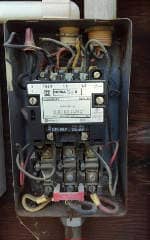
On 2019-10-19 by (mod) - 3 phase sub panel: wire colors Black Red Yellow 220VAC
Just based on looking at the terminal identification in your photo this looks like it might be a three-phase sub panel
If you are trained in safe and proper use of a digital multimeter or volt ohm meter then you could simply check the wires to confirm the voltage and which ones are live and where grounds are in that box.
It's too crowded into unlabeled for me think that I can do that from a photo.
Watch out if you're not trained on safe use of that electrical test equipment you should know that you could be shocked or killed. Take care..
On 2019-10-19 by Richard
Can't seem to find any documentation on the yellow-black-red 220v connection.
[Shown above]
On 2019-10-17 by (mod) - early knob and tube Edison type bulb socket light fixture?
I looked more-closely at your knob and tube fixture, Eleanor - it looks as if it was a light fixture and that the fixture center accepted a bulb; perhaps you can attach a sharper, closer photo.
It was common for lamp circuits to simply be screwed to a wood surface and wired as shown in your photo of knob and tube wiring.
On 2019-10-04 by Eleanor Lynn
These [round devices) were found throughout a historic building in Boston mostly at the ceiling and without anything attached to them.
I can't seem to identify the device. Looks like some type of terminal device for knob and tube wiring.
On 2019-08-11 by (mod) - electrical wiring inside aluminum sheath / conduit
It would be helpful to know the country and city of the home where this was found as well as the age of the home and whether or not there are any special environmental concerns that might have led to the use of this wiring.
Also we need to see the stripped back wire ends to show other readers that this is copper wire in an aluminum sheath
I suspect this was a form of pre-wired "conduit" using semi-flexible aluminum tubing. I've included your photo and further comments and research in the article ELECTRICAL WIRING TYPES.
Solid but flexible metal conduit (with rules about just how it may be bent) is using solid aluminum is one of several forms of pre-wired conduit that was probably intended for use in hazardous areas.
I've on occasion seen such industrial products used in the construction of private homes, perhaps because the owner or builder had a line on some "free" materials that fell off of the truck. So to speak.
On 2019-08-11 by Sean
Pulled this stufff out of a house. Couldn't get over how difficult it must have been to install. Aluminum sheath, cloth covered copper., three wire has loom and filler.
On 2019-08-06 by (mod) - how to identify the neutral & the hot wire in old wiring
Jim
When the wire insulation has lost its identifying color (White - neutral, black or red = hot) some other clues include
- The color of the screws to which wires were attached (if wiring was done correctly) where hot connects to the brass coloured screw and neutral to the silver or white screw
- Following the wire back to splices at which the color codes remain
- Using a VOM or DMM with power ON to confirm which conductor is carrying live current:
Watch out: if you do not know how to conduct electrical tests or to make wiring connections safely you could be shocked or killed or could burn the building down.
On 2019-08-06 by Jim - which wire is hot and which neutral ?
Old cloth wiring know color code how do I find neutral
On 2019-05-22 by (mod) -
Cathy there are two steps an electrician would take to determine which of those wires is hot and which neutral:
1. look back along each wire with care to find one that's more obviously colored white (neutral) and black (hot)
2. use a VOM to test for voltage - assuming that there's a convenient ground present
Watch out: if you're not familiar with safe electrical wiring and repair you should leave this alone and ask for help from a trained electrician - making a mistake can burn down the house or kill you.
On 2019-05-22 by Cathy My question is which is hot and which neutral ?
Which is hot and which is neutral?
IMAGE LOST by older version of Comments code - now fixed. Please re-post the image if you can. Sorry. Mod.
On 2019-01-17 by (mod) - Paraflex / Paranite photos
John
Thanks for the excellent Paraflex / Paranite photos; I've repeated your images along with an expansion of our text about Paraflex in the article FABRIC NMC WIRE INSULATION IDENTIFICATION where I include more historical research on Paraflex and Paranite.
Excerpt: If It's Paranite It's Right: Insulated electric wires, insulated electric cables and electrical insulating material including rubber, cotton, rayon, silk, and treated paper wrappings and rubber tape.
From reading the trademark disclosures I note that there was no mention of "asbestos" but my research is incomplete on the topic - I'm looking into more-detailed sources for that question.
You may need to clear your browser cache to see the updated article.
On 2019-01-17 by John Hathaway
One more clearer picture with 12/2 and 12/3 from elsewhere in the property.
IMAGE LOST by older version of Comments code - now fixed. Please re-post the image if you can. Sorry. Mod.
Sorry, forgot to say, this is from a single family built in 1962-1963 in San Jose, California.
I looked at the section you mention above and it sounds like you are saying it may have asbestos in the sheathing. Is that a correct assessment? Is that correct for residential at the time of this build, or is it more for public structures like movie theatres, etc.
Thanks again. This is an extremely valuable site and I would donate a few bucks to help keep it running if you told me how.
On 2019-01-17 by (mod) -
Hi John,
Above on this page in the section titled
Fabric Covered NMC Electrical Wire Insulation
you will see a photo of what I think is the same as your wire
Can you tell the country and city and age of the building where your wire is found?
On 2019-01-17 by John Hathaway
One more picture
IMAGE LOST by older version of Comments code - now fixed. Please re-post the image if you can. Sorry. Mod.
Hi, I would really appreciate any observations of these wires. Do you believe there is a risk they contain asbestos?
IMAGE LOST by older version of Comments code - now fixed. Please re-post the image if you can. Sorry. Mod.
On 2018-12-20 by Bay Home Inspections
I came across an unusual device in a turn of the century structure (1924 mansion). I am assuming this is an old K & T floor mounted electrical receptacle plate, but not sure. Any clue?
IMAGE LOST by older version of Comments code - now fixed. Please re-post the image if you can. Sorry. Mod.
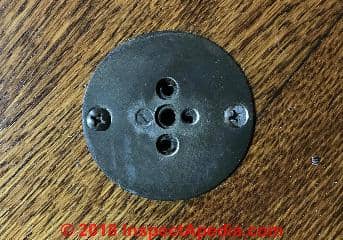 On 2018-12-20 by (mod) - round pin floor receptacle
On 2018-12-20 by (mod) - round pin floor receptacle
Hi Bay State.
I think the receptacle shown in your photo is an early Hubbell wall receptacle that was in use in the U.S. before the popular adoption of Hubbell's tandem and later parallel flat blade receptacles and wall plugs.
At our separate article on ELECTRICAL RECEPTACLE TYPES
I'll add some detail about this and repeat your photo along with notes on this patent:
Hubbell, Harvey. "Multiple attachment-plug." U.S. Patent 776,326, issued November 29, 1904 shows similar attachments.
In the future if you come across interesting and unfamiliar electrical receptacles or wall plugs, it would be helpful if you could include a small ruler or measuring tape in the photo to give us scale and dimensions.
Of course if there was access below this floor you might have been able to note the wiring present there as well as the number of conductors.
As knob and tube wiring generally includes only a hot and neutral (no ground wire), it's interesting to see this round pin receptacle that appears to have three openings and a screw opening where a mounting screw is lost - suggesting it accepted a grounded receptacle plug.
Below is an excerpt from the drawing from the relevant Hubbell patent.
Please see details at ELECTRICAL RECEPTACLE TYPES
On 2018-12-20 by Bay Home Inspections
I came across an unusual device in a turn of the century structure (1924 mansion). I am assuming this is an old K & T floor mounted electrical receptacle plate, but not sure. Any clue?
On 2018-11-18 by (mod) - My question is which is hot and which neutral ?
Normally the white wire is neutral.
A qualified electrician would never bet your house, life, and her reputation on an assumption. She'd use a VOM or DMM to confirm hot and neutral wire identity.
On 2018-11-16 by stu - 2-wire ceiling light
I have a 2 wire light ceiling light in my old house, the wire is old romex the wire got like a braid cloth over plastic 1 wire is white the other is white with a black strip on the cloth the plastic are both black !
My question is which is hot and which neutral ?
On 2018-11-13 by (mod) - red, black, white color codes
Usually red and black are hot 120VAC and the white is neutral.
An electrician would use a simple neon tester or a VOM or DMM to identify hot and neutral and to confirm the voltage.
Watch out: if you don't know how to do electrical wiring safely you could be shocked or killed or could burn down the house.
In the ARTICLE INDEX you'll find articles on electrical wire color codes and markings.
On 2018-11-12 by Jennae
My house was built in 1955. The electrical wires in the wall are black, red and white. There is no green. The white wire is way in the back and enters from below the receptacle and exits the top without being attached to the electric wall switch.
This switch turns my outside porch lights on/off. When installing the Simple Set In-Wall timer (added a ground wire), the unit will not operate.
I used the black and red wires (hot) and installed a grounding wire. There is no green wire and the white wires is hooked up to who knows what. Help!!
Jennae Arrias timeends@yahoo.com
On 2018-10-24 by (mod) - fuses keep blowing
I would look for a shorted hot or neutral wire, starting close to the box where you were working.
On 2018-10-24 by Craig Hansley
Ive got hot wires coming from ceiling n bedroom running lights in garage i have 3 different sets of white n black n a ground wire one set is my hot wires white is neutral i keep blowing fuses in this old house no matter which way i wire it need help
On 2018-05-21 by (mod) - steel electrical wire in buildings?
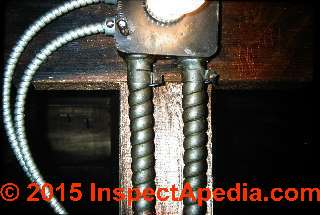 Tim:
Tim:
There steel wire earlier was produced and used in early electrical wiring life, Tim. I recall having come across it.
Before assuming your wire is steel check for tinned copper: scratch the "steel" or silver color to see if you expose red copper - that's more-likely to be the case.
But insulated steel electrical wiring is likely to be quite rare in a typical residential building.
Early electrical wiring used steel before people found that copper was not only a great conductor, but corrosion resistant compared to some other metals.
Rutherford, Ernest. "A magnetic detector of electrical waves and some of its applications." Proceedings of the Royal Society of London 60, no. 359-367 (1897): 184-186.
This proceeding includes a description of the preparation of steel electrical wires.
Excerpt: Detectors made of very fine steel Wire may be used to investigate waves along wires and free vibrating circuits of short wave-length. Fine wire detectors are of the same order of sensitiveness as the bolorneter for showing.
And of course steel wire is used in high resistance applications such as electric heating devices and appliances.
Stainless steel electrical wire is still produced and might be used in medical applications (produced by Stäubli) , equipment, perhaps certain hospital wiring. I would not expect to find it in a residential building.
I would very much like to see some shark photos of the wire the jacketing end or the actual conductor looks like. You can of course attach a photo to a comment on this page.
From Stäubli
The Teflipuls and Silipuls are specially created for use with medical applications. They are integrated with multi-strand wires that are built from stainless steel materials. A corrosion resistance, and an extensive breaking strength feature is also incorporated.
These insulated and space-saving electrical wires can be utilized in pulse transmission operations. - source: http://www.directindustry.com/prod/staeubli-electrical-connectors/product-7083-607862.html
On 2018-05-18 by Tim
I found old cloth covered, rubber insulated wiring in a house that was supposedly built in the early 1940s. Both conductors were steel. Not tinned copper, not aluminum but steel. I have never seen that before. Is this something that is rare? Sorry I don't have a picture.
On 2018-05-03 00:13:14.290077 by (mod) -
Nice, Kevin
On 2018-05-02 by (mod) - Hubble type floor receptacle
Your photo (below) looks like a later tandem-blade Hubble type floor receptacle. These replaced the round-prong receptacles and were later replaced by parallel-blade plugs and receptacles as early as 1904 but probably a bit later, perhaps 1910.
On 2018-05-02 23:57:32.121903 by Kevin
1910 home (knob and tube wiring) on West coast designed by Gustav Stickley......thanks
On 2018-02-11 by (mod) - which wire is hot?
Joe
Watch out: using a DMM or VOM in the hands of a trained electrician the wires an be reliably identified. I would not bet your life on a correct "guess" at wires put in 50 years ago.
I can say that by convention I'd expect the black wire to be hot, yellow to be aged white neutral, and purple may be a second hot line or it could have been used as a ground. A meter is needed.
On 2018-02-11 by Joe Gatz
Have a 50 year old outlet box with a black, yellow and purple wires. Black is hot I think, what are the others
On 2018-02-09 by (mod) - piglet plugs ?
Chris
I appreciate the question but I am pigged out - I don't know that term, didn't find it on research. It'd help if I knew we were talking about gas piping connectors, electrical connectors for the igniter system, or something else.
Or use the picture frame icon to the right of the Comment button to send me a photo of your piglet.
Or look at the gas range connector hookup kit photo I'll attach and tell me if it's one of those parts.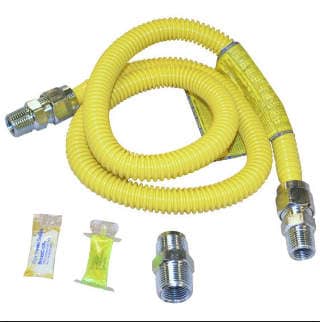
On 2018-02-08 by chris
On the back of a gas stove was that plug called a piglet or something like that?
On 2017-10-02 by Don
Is there a difference in the load carrying capacity of the cloth braided 8/3 vs. modern 8/3? -- or other wire for wire gauges from the 1950's?
On 2017-01-27 by Rick R
Can you inform me when exactly Romex cable wiring was code mandated in new residential construction in the county of Clearlake, Ca
On 2016-10-20 1 by (mod) - where I can purchase an 8' length of 1/8" diameter brown round cloth wire.
Mike, I'm confused about just what type and size of electrical wire you need. Please see https://inspectapedia.com/electric/Electrical_SEC_Sizes_Amps.php
On 2016-10-20 by Mike
Wondering if you have or know where I can purchase an 8' length of 1/8" diameter brown round cloth wire. All I can find is 1/4" diameter.
Much appreciated,
Mike
Question: suspected electrical short circuit increasing electricity usage in an older home?
30 Jul 2015 Bruce E said:
Hello, thank you for the wonderful website, it has been of great help to me for years now.
I have a 1974 home in Maine, a ranch with 200 amp breaker box service. I also have power bills around 50% higher than they should be.
I have not been able to afford to have the kind of exploratory work done to find the problem, but I did find some thing odd in a wall outlet the other night. It is mid circuit in a metal box in the wood paneling by the brick chimney. The top of the box is clean, but the inside of the bottom has some white corrosion.
The lower hot and neutral pair are dark from age but also have green corrosion where they wrap around the terminal screw, but the upper pair do not. I thought water or perhaps mouse urine from the attic, but then the top outside of the box would be corroded too, as would the top pair of hot and neutral wires.
A simple circuit tester shows the wiring to be double green correct. Here is the weirdest part, the power strip/protector plugged into he TOP outlet, the blades are clean, but when I unplugged it the ground pin is a corroded mess.
At some point the the upper hot must have touched somewhere because there is a bright brass splash in the screw, and it has not darkened over time--it looks polished.
The inconsistencies make no sense to me but I hope they might to you, and maybe a solution to my many thousands of dollars in power I have never used.
Thank you for reading my lengthy post--I can send pictures if that would help. Bruce E
Reply: simple DIY observation to identify the main users of electrical power in a home
Bruce
Find our email at the page bottom CONTACT link to send me some sharp photos and we can comment further.
You can find the energy users in your home quite easily if somewhat subjectively.
Stand at the meter and watch the dial spin rate (or time it to be more accurate) or on a digital meter note the number change rate per second or 30 seconds.
Start turning off circuits in the home. One or two of them will usually define the main energy users in the home when you see the electric meter spin rate drop significantly.
Make a note of what appliances (or in your theory current shorts to ground) that are located on that circuit and you've got a good idea who's using the juice. Typically these are air conditioners, refrigerators, electric heaters.
An electrician can perform a similar but more precise task using an ammeter
...
Continue reading at OLD ELECTRICAL WIRING TYPES - topic home, or select a topic from the closely-related articles below, or see the complete ARTICLE INDEX.
Or see these
Recommended Articles
- ASBESTOS ELECTRICAL WIRE INSULATION
- ELECTRICAL COMPONENTS, AGE, TYPES
- ELECTRICAL GROUNDING in OLDER HOMES
- ELECTRICAL PANEL AGE
- KNOB & TUBE WIRING
- OLD HOUSE ELECTRICAL SYSTEMS
- ANTIQUE & OLD ELECTRICAL RECEPTACLES
- ANTIQUE LAMPS (BULBS) & CONNECTOR TYPES
- ANTIQUE LAMPS (BULBS) LIGHT OUTPUT - LUMENS
- OLD ELECTRICAL WIRING TYPES
- SOLID PIPE EDISON DC CABLE HISTORY
Suggested citation for this web page
OLD ELECTRICAL WIRING FAQs at InspectApedia.com - online encyclopedia of building & environmental inspection, testing, diagnosis, repair, & problem prevention advice.
Or see this
INDEX to RELATED ARTICLES: ARTICLE INDEX to ELECTRICAL INSPECTION & TESTING
Or use the SEARCH BOX found below to Ask a Question or Search InspectApedia
Ask a Question or Search InspectApedia
Try the search box just below, or if you prefer, post a question or comment in the Comments box below and we will respond promptly.
Search the InspectApedia website
Note: appearance of your Comment below may be delayed: if your comment contains an image, photograph, web link, or text that looks to the software as if it might be a web link, your posting will appear after it has been approved by a moderator. Apologies for the delay.
Only one image can be added per comment but you can post as many comments, and therefore images, as you like.
You will not receive a notification when a response to your question has been posted.
Please bookmark this page to make it easy for you to check back for our response.
Our Comment Box is provided by Countable Web Productions countable.ca
Citations & References
In addition to any citations in the article above, a full list is available on request.
- Our recommended books about building & mechanical systems design, inspection, problem diagnosis, and repair, and about indoor environment and IAQ testing, diagnosis, and cleanup are at the InspectAPedia Bookstore. Also see our Book Reviews - InspectAPedia.
- In addition to citations & references found in this article, see the research citations given at the end of the related articles found at our suggested
CONTINUE READING or RECOMMENDED ARTICLES.
- Carson, Dunlop & Associates Ltd., 120 Carlton Street Suite 407, Toronto ON M5A 4K2. Tel: (416) 964-9415 1-800-268-7070 Email: info@carsondunlop.com. Alan Carson is a past president of ASHI, the American Society of Home Inspectors.
Thanks to Alan Carson and Bob Dunlop, for permission for InspectAPedia to use text excerpts from The HOME REFERENCE BOOK - the Encyclopedia of Homes and to use illustrations from The ILLUSTRATED HOME .
Carson Dunlop Associates provides extensive home inspection education and report writing material. In gratitude we provide links to tsome Carson Dunlop Associates products and services.



